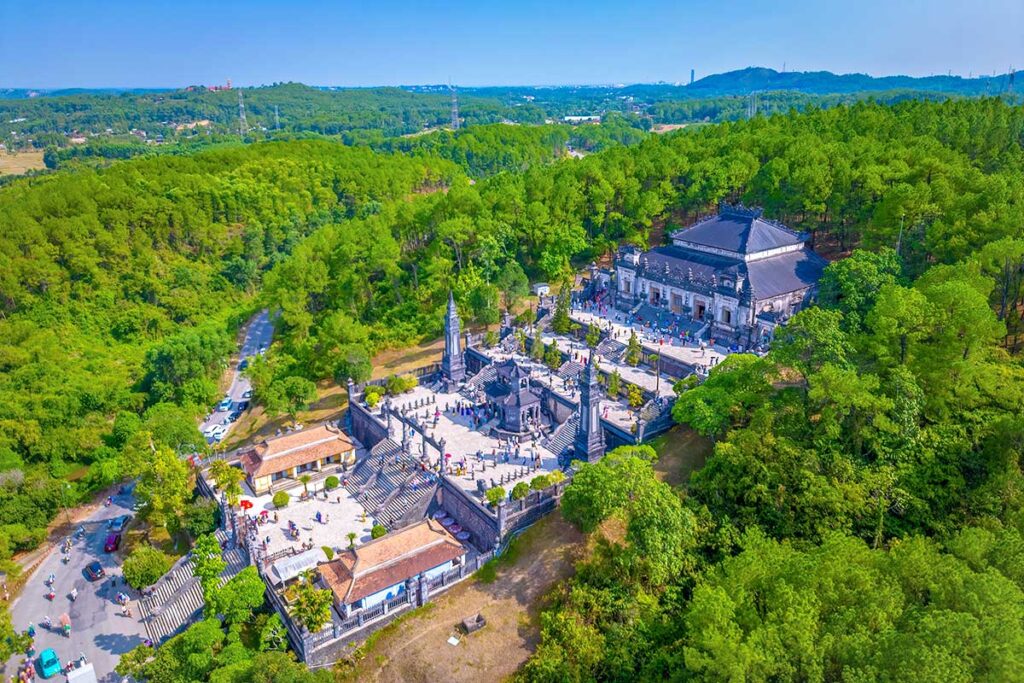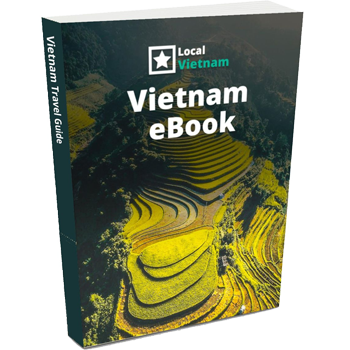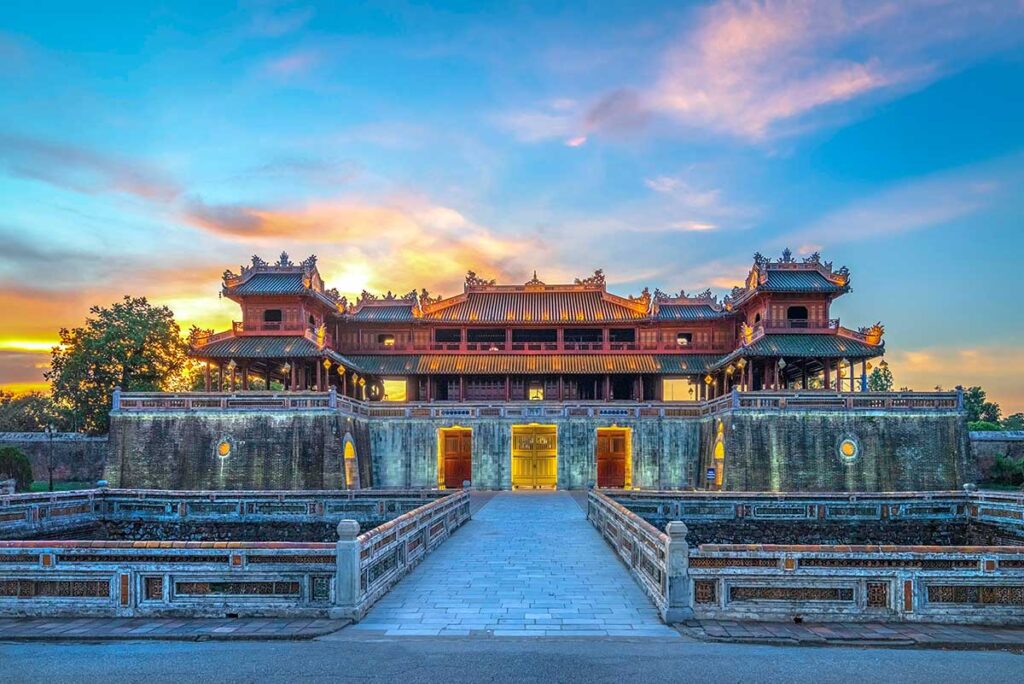What is Khai Dinh Tomb?
The mausoleum of Emperor Khai Dinh is a royal tomb located in the hills just outside of Hue, the former capital of Vietnam’s Nguyen Dynasty. Compared to other imperial tombs in the area, it stands out for its blend of Vietnamese and European design, its steep layout, and its elaborate mosaic interiors. Like other Nguyen emperors, Khai Dinh built his tomb during his lifetime, and today it remains one of Hue’s most unique historical landmarks.
Who was emperor Khai Dinh?
Emperor Khai Dinh (1885–1925) was the 12th ruler of the Nguyen Dynasty and one of its most controversial. He came to power during a time when Vietnam was firmly under French colonial control, and he is often remembered for his close cooperation with the French authorities. This earned him criticism from nationalists, but also gave him access to European ideas, which influenced his tastes and lifestyle.
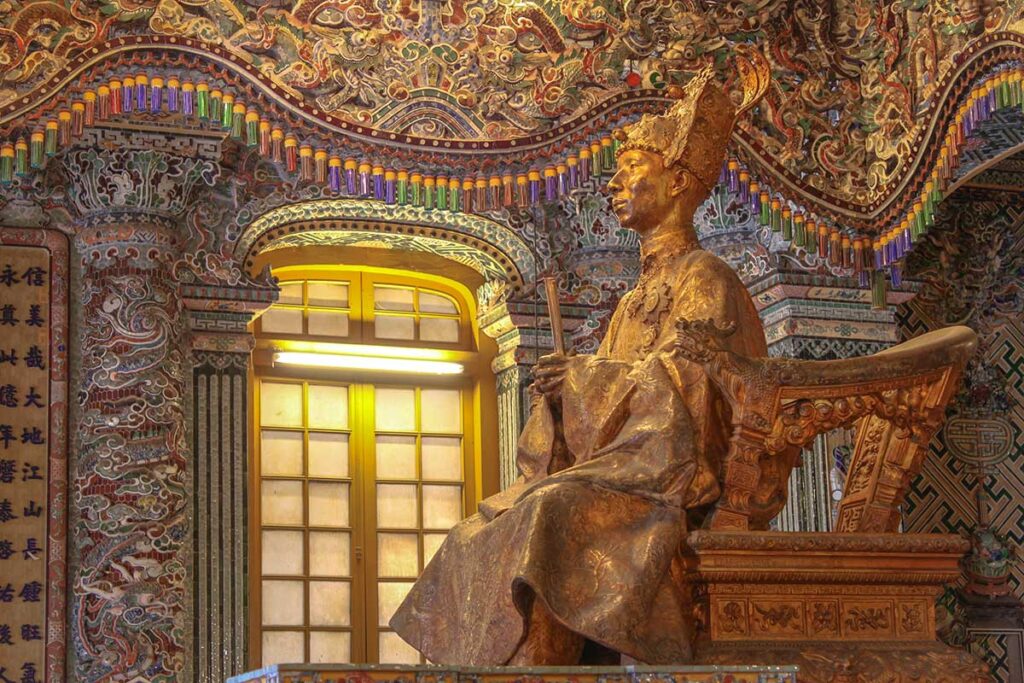
Khai Dinh was known for his love of art, architecture, and modern comforts. He introduced Western-style reforms at court, adopted new materials and techniques, and lived more lavishly than his predecessors. He died in 1925 after a short 9-year reign, and his legacy remains closely tied to the cultural fusion seen during his time on the throne.
History of Khai Dinh Tomb
Construction of the mausoleum of Emperor Khai Dinh began in 1920, during the emperor’s reign, and took 11 years to complete—making it the last imperial tomb ever built in Hue. Khai Dinh personally chose the location on Chau Chu Mountain, about 10 kilometers southwest of the city, where the tomb would overlook the countryside and stand out against the hillside. The long construction period meant that the tomb was only completed after his death in 1925, by his son and successor, Emperor Bao Dai.
Unlike earlier Nguyen emperors who favored large, natural landscapes, Khai Dinh wanted a smaller but more elaborate structure—using imported materials like iron, concrete, and ceramics. The design reflected his interest in European architecture and modern technology, including electricity and glass windows, which were new for royal Vietnamese construction at the time. The tomb’s history is closely tied to the emperor’s personal taste and the colonial context of the era, making it one of the most distinctive legacies of the late Nguyen period.
Highlights & architecture
The mausoleum of Emperor Khai Dinh is unlike any other royal tomb in Hue. Built into a steep hillside and constructed with dark stone, concrete, and iron, it has a stark, almost Gothic appearance from the outside.
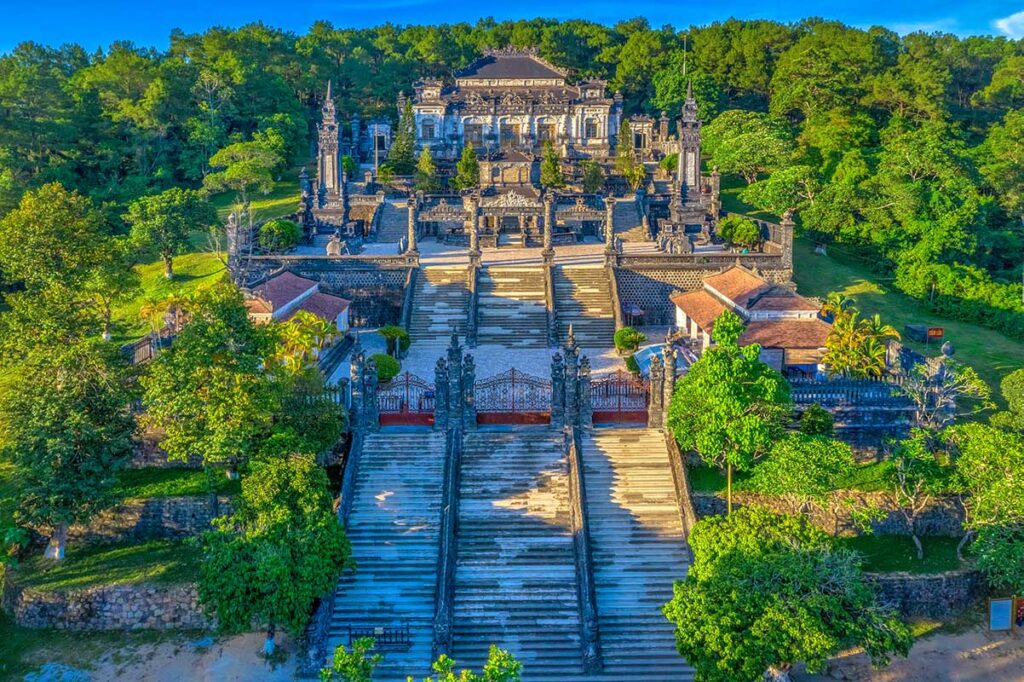
Instead of sprawling gardens and lakes like earlier tombs, this one climbs upward in a tight, layered structure that’s all about bold design and rich detail. Though the complex is smaller than other tombs, it’s packed with visual surprises and a blend of Vietnamese and European architectural elements.
1. Staircase and Dragon Pillars
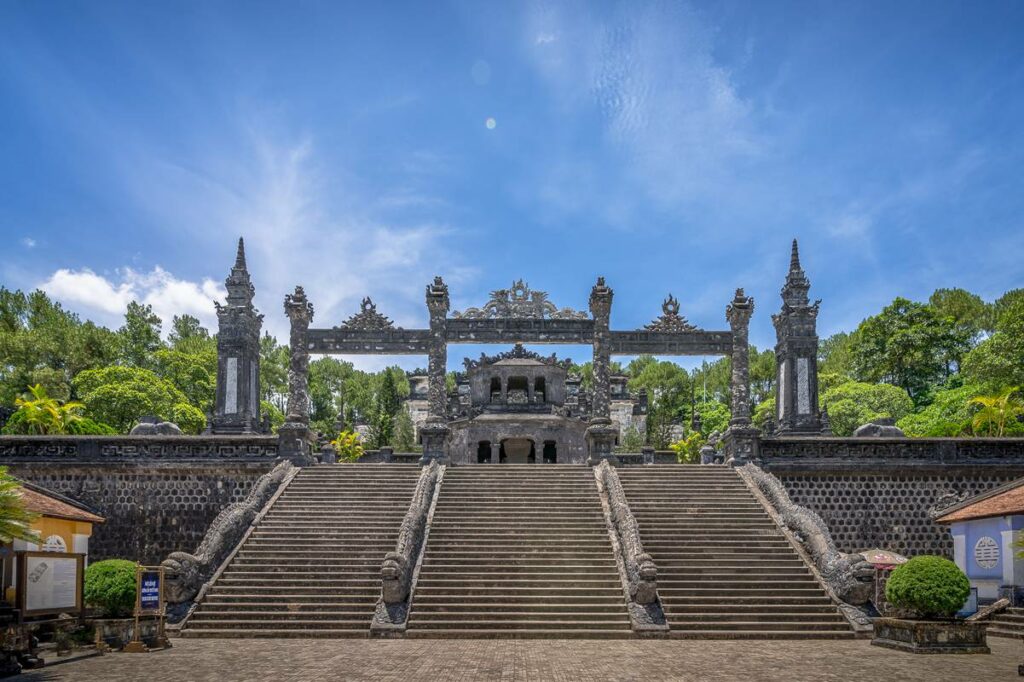
Your visit starts with a steep climb—127 steps, to be exact. The lower staircases are lined with stone dragon pillars, leading you gradually higher through the structure. The climb gives you striking views of the blackened concrete walls and the layered symmetry of the tomb, especially atmospheric on cloudy days.
2. Honor Courtyard (Bai Dinh Yard)
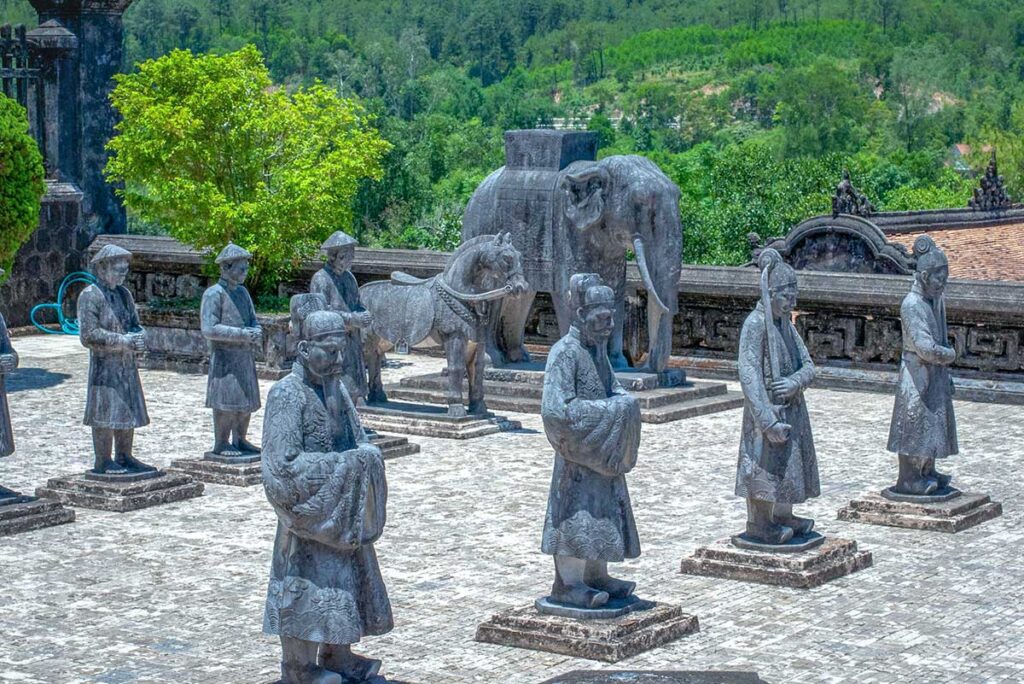
At the top of the first terrace is the courtyard of stone statues, featuring life-size mandarins, elephants, horses, and soldiers. These figures were carved with remarkable detail—each face different—meant to serve the emperor in the afterlife. The dark stone and European-style columns around the courtyard give it a unique, slightly surreal look compared to other tombs in Hue.

In the center of the courtyard is an octagonal stele pavilion, housing a 10-ton stone stele that records Khai Dinh’s life and reign. The size and craftsmanship of this monument add weight—literally and symbolically—to the space.
3. Thien Dinh Palace

This is the architectural heart of the tomb and sits on the uppermost terrace. From the outside, it looks heavy and fortress-like, but once inside, it completely transforms.
The interior is covered floor-to-ceiling with colorful mosaics, painted plaster, glass inlay, and porcelain fragments. It’s an overwhelming mix of patterns and decoration that includes dragons, flowers, and imperial symbols in bold colors.
4. Khai Thanh Hall (inside Thien Dinh Palace)
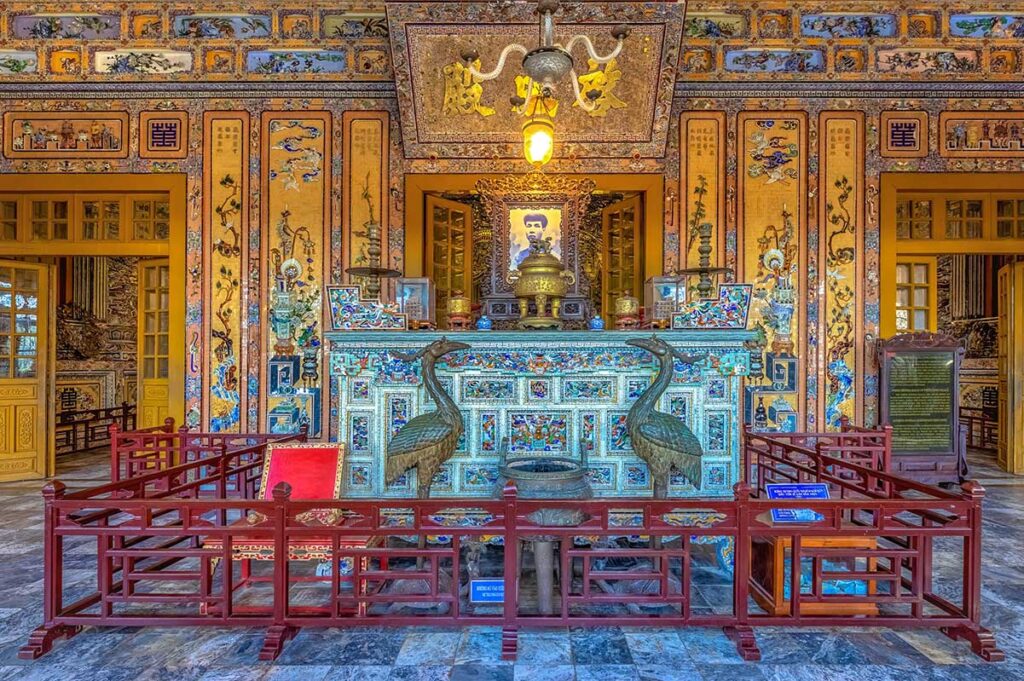
At the center of the palace is Khai Thanh Hall, where the emperor was worshipped after his death. Its walls are painted with murals of the four seasons, and the ceiling features the only remaining painted ceiling in Vietnam. The mix of gold, enamel, and colored glass here is unlike anything else you’ll see in Vietnamese royal architecture. This room alone makes the tomb worth visiting.
5. The Bronze Statues of Emperor Khai Dinh

At the rear of Khai Thanh Hall is a life-size bronze statue of Emperor Khai Dinh seated on a throne, placed above his actual sarcophagus, which lies 18 meters below in a stone crypt. This statue was cast in Paris and then gilded by Vietnamese craftsmen.
A second standing bronze statue, made by a local artisan from Quang Nam, is also displayed within the palace. Originally kept in An Dinh Palace, it was moved to the tomb in 1975 and adds another layer of artistic and historical interest.
6. Panoramic views from the upper terrace

Because the mausoleum is built into Chau Chu Mountain, it offers excellent views over the surrounding hills and countryside. The contrast between the tomb’s dark, bold structures and the green landscape makes for great photos and a striking overall impression.
Visiting information & Practical tips
Hue Historical City Tour By Small Group or Private Tour
- Includes: Hue Imperial City, royal tombs, and a scenic dragon boat ride.
- Flexibility: Private option lets you customize the itinerary to your interests.
Location
The mausoleum of Emperor Khai Dinh is located on Chau Chu Mountain, in Thuy Bang Commune, about 10 kilometers southwest of Hue city center. It’s perched on a hillside, offering wide views of the surrounding countryside and making it one of the most dramatic tomb locations in Hue.
Entrance fee
As of 2025, ticket prices are:
- Adults: 150,000 VND
- Children (7–12 years old): 30,000 VND
- Children under 7: Free
Combo tickets are available if you plan to visit other tombs or the Imperial City on the same day.
Opening times
The tomb is open daily from 7:00 AM to 5:30 PM. Arriving early or late in the day is a good way to avoid the hottest hours and larger tour groups.
Dress code
There’s no official dress code, but it’s best to dress modestly out of respect for the site. Clothing that covers shoulders and knees is recommended. Light, breathable fabrics are ideal due to the climb and warm weather.
Guides
You can visit the tomb on your own, and many travelers do, but there’s not much signage explaining the emperor’s life or the meaning behind the designs. Hiring a guide—either on-site or through a private tour—can help you understand more of the symbolism and background, especially inside Thien Dinh Palace.
Nearby sights
While the mausoleum of Emperor Khai Dinh isn’t right next to other tombs, it’s in the same general area as two other major sites and can be easily combined into a half-day trip:
- Mausoleum of Emperor Thieu Tri – A quieter, less-visited site with a more open design and two parallel axes. Good to pair if you’re looking to explore beyond the main tourist spots.
- Tomb of Minh Mang – Known for its peaceful natural setting and symmetrical layout, this is one of the most beautiful and traditional royal tombs in Hue.
How to get to the Mausoleum of Emperor Khai Dinh
Taxi or grab app
One of the easiest ways to reach the mausoleum of Emperor Khai Dinh is by taxi or the Grab app. The site is about 10 km from Hue’s city center, and the ride usually takes around 20–25 minutes.
- A one-way taxi fare typically costs between 150,000–200,000 VND. You can ask the driver to wait if you want a round trip—just agree on a price in advance.
- Grab works like Uber and is widely used in Hue. You can choose between GrabCar or GrabBike (motorbike taxi), with the price shown before you book.
- Grab is reliable from the city, but it may be harder to find a return ride from the tomb area—especially during off-peak times.
Cycling or scooter
If you’re comfortable riding in Vietnamese traffic, scooters and bicycles offer more flexibility and the chance to explore at your own pace.
- A scooter is a great option for visiting several tombs in one trip. Rentals are easy to arrange in Hue, and 50cc models are available for travelers without a local license.
- Cycling is doable, but the route includes some hills, especially toward the final stretch. The views are great, but you’ll want to bring water and sun protection—especially on a hot day.
Tour
The mausoleum of Emperor Khai Dinh is included in many group tours of Hue’s royal tombs. These tours usually include comfortable transfers in a limousine-style van, a licensed guide, and entry tickets to several main sites—often including Minh Mang Tomb, Thien Mu Pagoda, and the Imperial City. It’s an easy, well-organized option if you want to see multiple places in one day.
If you prefer more flexibility, a private tour is another great choice. You can create your own itinerary, choose how much time to spend at each stop, and even include lesser-visited tombs like Gia Long or Thieu Tri. Private tours can be arranged through most local agencies or online in advance.
More historical sights in Hue
Besides the mausoleum of Emperor Khai Dinh, Hue is full of important sites from the time of the Nguyen Dynasty, Vietnam’s last imperial rulers. The city served as the royal capital for over a century, and many emperors built tombs, temples, and palaces that still stand today. If you’re interested in history, these nearby landmarks are well worth including in your visit.
- Hue Imperial City – A large walled citadel at the heart of Hue. Once the official seat of the Nguyen emperors, it includes royal gates, palaces, temples, and administrative buildings, many of which are now being restored.
- Mausoleum of Emperor Tu Duc – A peaceful tomb set among pine trees and lotus ponds, built by the emperor himself as both a retreat and a resting place. Known for its poetic atmosphere and elegant architecture.
- Tomb of Minh Mang – A majestic tomb with a symmetrical layout, reflecting Confucian principles and the emperor’s strong personality. Surrounded by lakes, bridges, and manicured gardens.
- Mausoleum of Emperor Gia Long – The most remote of all Hue’s imperial tombs, located in a quiet forested area. Less visited, but offers a tranquil setting and historical importance as the resting place of the Nguyen Dynasty’s founder.
- Thien Mu Pagoda – One of Hue’s most iconic religious sites, located along the Perfume River. Its seven-story tower and peaceful riverside location make it a popular stop for both cultural and scenic value.
